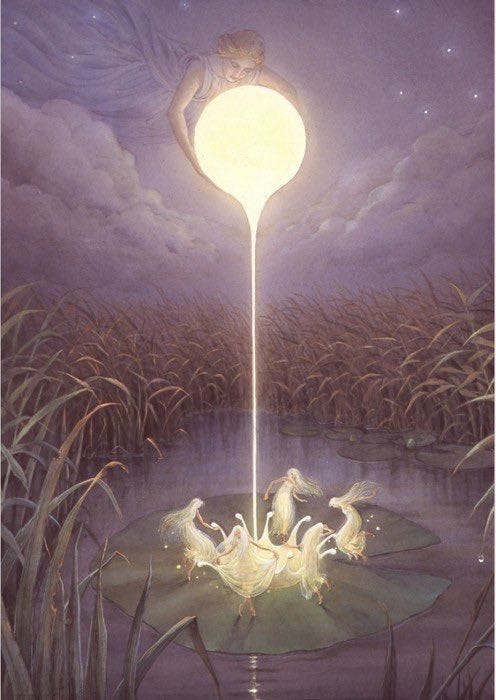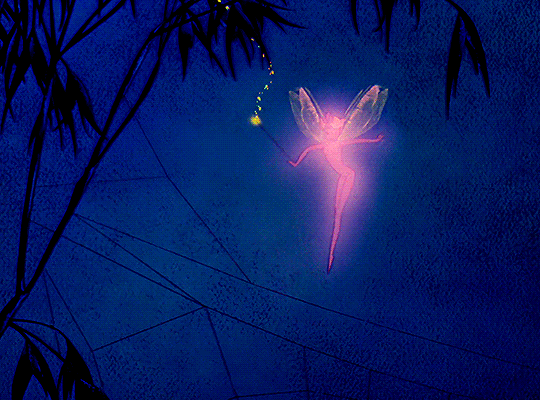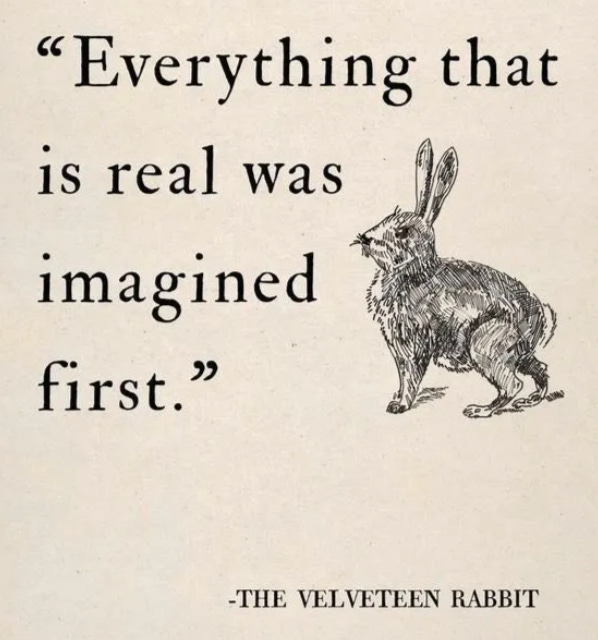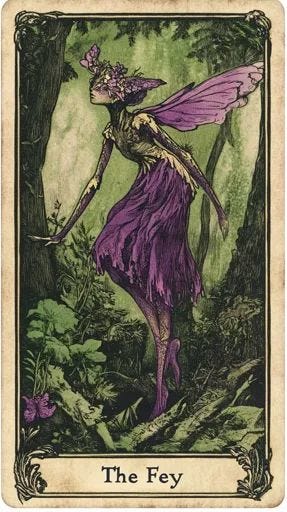why you should believe in fairies
delusion, magic, and the architecture of reality
chant until it’s true
There’s a line from Peter Pan that felt strangely true to me, even as a child: “I do believe in fairies, I do, I do.” I was eight when I first heard it and I didn’t yet know then how much of life would turn out to work like that.
The line arrives at a particularly tender moment of the story. Tinker Bell, having drunk the poisoned medicine meant for Peter, is dying. Her light, once sharp and mischievous, is flickering faintly now, on the edge of going out. Peter, panicked, turns to the audience. He breaks the fourth wall and pleads with us, saying that she can live, but only if we believe. So he begs: Clap. Say it with me. “I do believe in fairies. I do! I do!”
Then, something remarkable happens. The theatre, until moments ago just a theatre, becomes a spell circle, a strange and trembling communion. Dozens, then hundreds of children begin to chant, whispering it, then shouting it, then sobbing it.
“I do believe in fairies!”
Just when it seems like her light has gone out forever, Tinker Bell begins to glow again. She comes back to life through sheer, collective belief, through the fragile but undeniable power of many small voices willing her into being.
I still think it’s one of the most moving pieces of metaphysics ever smuggled into a children’s play, because the lesson, of course, isn’t just about fairies. It’s about everything in this world that is delicate, and improbable, and good. These are the kinds of things that only survive if we believe in them first.
That moment branded itself into me, so deeply in fact, that I have a tattoo of fairies with the quote inked along my side. It taught me something I’m still trying to live by: sometimes belief precedes reality and you need to cultivate it even before you have evidence. Sometimes it’s the very act of belief itself that makes things real.
magical realism as metaphysics
People call magical realism a genre, but I think it’s more of a worldview, like a spell you cast on yourself so you can see the world not just as it is, but as it could be. It’s about living like the veil is thin, like beauty and absurdity and sacred coincidence are trying to get your attention, like there are cathedrals hidden inside office buildings, and miracles dressed up as coincidences.
This is nothing to do with ignoring the pain or injustice of the world, but rather refusing to let that be the whole story. The world is obviously often brutal and endlessly painful, but it is also endlessly awe-inducing. Babies are born. Friends fall in love. Strangers save each other from fires and floods and despair. Sometimes it all works out and sometimes it works better than expected. There is magic everywhere, unless you’ve trained yourself not to see it. As I often quote on this blog, John Keats says: The world is full of magic things, patiently waiting for our senses to grow sharper. Put another way, there are fairies everywhere, patiently waiting for us to believe in them,
Some people call it manifestation, speaking things into existence, declaring a reality before it arrives. While the language can feel a little glittery, they have a point echoed in neuroscience and psychology.
Your beliefs shape your actions, just as much they do your inner world. What you believe determines what you allow, what you pursue, what you tolerate. Your beliefs influence how you speak to yourself, what risks you take, and what behaviours you accept in your life.
Over time, those choices reframe your reality. In that sense, belief is co-creative, beyond just an internal process. You and the world are building the thing together. To manifest something is simply to live as if it’s already on its way, long enough, and stubbornly enough, that the world eventually catches up.
the velveteen rabbit
If you’ve never come across it, The Velveteen Rabbit is a children’s book written in 1922 by Margery Williams. It tells the story of a stuffed rabbit who longs to become Real, something alive and true, more than a toy.
The other toys in the nursery mock him for this. All except for the Skin Horse, the oldest and wisest of them, who understands that becoming Real is a quiet kind of magic. One day, the rabbit asks the Skin Horse: What is Real? The Skin Horse replies:
“Real isn’t how you are made…
It’s a thing that happens to you.
When a child loves you for a long, long time,
not just to play with, but really loves you,
then you become Real.”
Like Peter Pan, it’s one of those deceptively simple lines in children’s literature, because ideas, dreams, companies, movies, buildings, projects, futures: they all begin as fragile, flickering nothings. They must be believed, midwifed into being, before they arrive with mass or form.
They survive only if someone carries them through their awkward beginnings, through the phase where they look premature, or unrealistic. Someone has to speak them aloud when no one else does, to say: Yes, I believe in this. That stubborn, irrational devotion, is what slowly makes them real.
The Velveteen Rabbit is about the slow alchemy of belief and how the act of staying with something transforms it from imaginary to actual. Everything worth anything was once a trembling little maybe, and the only way it became something undeniable was because someone believed in it first.
predictive coding and fairy logic
Here’s a fun detour into neuroscience: the brain is a prediction machine. This theory is called predictive coding, and it says: we don’t see the world as it is. We see what we expect to see, and then update when surprised.
Our brains are constantly generating guesses about what’s out there, based on memory, context, emotion, past experience. What you perceive is beyond raw sensory input, created from your brain’s best guess, stitched together from prior assumptions. As I talk about often on this blog, reality, in this model, is constructed, rather than revealed. Only when something unexpected happens, does the brain update. Surprise forces a recalibration. But until then? You live inside your expectations.
This means that beliefs shape perception, metaphorically and neurologically. So if you believe the world is dangerous, your brain is more likely to filter for threats. If you believe people are unkind, you’ll notice every slight and miss every smile. If you believe you are unlovable, you will, heartbreakingly, miss the evidence to the contrary.
But this also means: If you begin to believe in beauty, you will start to notice it.
If you start to trust in the possibility of good things, your perceptual field will subtly shift to let them in and you’ll start to register the fairy lights.
Attention is prophecy. Where you direct it determines what kind of world you perceive, and what kind of self you become. This is why belief matters, because an active lens through which the world is rendered. The more you attend to something, the more real it becomes.
So, scientifically, if you believe in fairies, you're more likely to see them. These fairies are a belief literally opens the aperture of perception, far from hallucination. They are always fluttering at the edge of your vision, waiting for you to tune your instrument to the right frequency.
the necessary delusion
A lot of things in life work like this: If you don’t believe in a better future for yourself or the world, it simply won’t happen. If you don’t believe you’re worthy of love, you’ll sabotage every time someone tries to show you (a la ‘we accept the love we think we deserve’). If you don’t believe your art is worth making, you’ll never finish it.
I’ve come to think there’s a particular kind of delusion that’s actually necessary for creation. People call themselves delusional like it’s an insult, but every brilliant thing was “delusional” at the start. The iPhone, flying machines, falling in love with someone before you know whether they’ll love you back. All creation requires a temporary divorce from consensus reality.
You have to let yourself believe in something before it exists. You have to risk being the odd one in the room, the only one clapping, the one with fairy dust on your fingers.
Yes, sometimes delusion is delusion. There are moments when we deceive ourselves or project fantasies onto others or refuse to accept hard truths. But I worry we let the fear of being delusional stop us from believing in anything at all. Better to risk looking foolish than to never try. Better to build a cathedral that no one else sees, yet, than to become the kind of person who stops imagining.
staying lucid in a sleepwalking world
The most important beliefs in life are all slightly irrational. They’re chosen, before they are ever earned. You don’t believe in fairies because you’ve seen one. You see one because you believe. You believe in love when the world is full of heartbreak. You believe in beauty in a sea of suffering. You believe in trying again when you’ve failed before.
That belief is profoundly generative, because everything that is real was imagined first. Because if no one believes in the fairies, they disappear. Because if we all stop believing in goodness, what happens to the world? Maybe we’re all dreams, dreaming ourselves into being. We begin as the dreams of our parents, and then, somehow, we inherit the ability to dream for ourselves.
So, with all my might, I do believe in fairies. I do, I do, I do. 🧚 Do you?








Had so much fun reading this! Thank you
Loved this!!!!